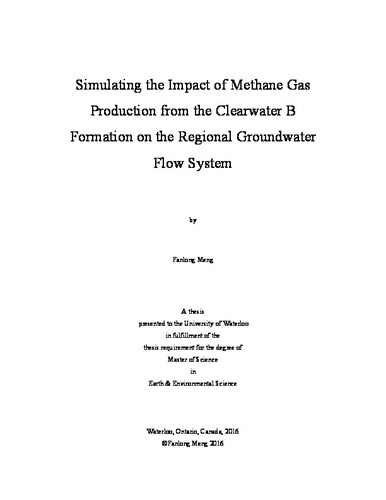| dc.contributor.author | Meng, Fanlong | |
| dc.date.accessioned | 2016-01-19 19:43:09 (GMT) | |
| dc.date.available | 2016-01-19 19:43:09 (GMT) | |
| dc.date.issued | 2016-01-19 | |
| dc.date.submitted | 2016-01-19 | |
| dc.identifier.uri | http://hdl.handle.net/10012/10166 | |
| dc.description.abstract | The production of natural gas from a saline aquifer will reduce the pressure regime in that aquifer to some degree. Simultaneously, this relief in pressure will causes gas to be exsolved out of the aqueous phase, which will partially mitigate this reduction in pressure. In terms of groundwater resources, the net effect of these two processes results in a reduction of pore water pressure within the aquifer, the surrounding groundwater system, and potentially the surface water system. Previous work has shown that results generated by the single-phase groundwater models used in Alberta’s oil sands typically over-predict aquifer hydraulic heads in regions where gas production activities are intensive. Over-prediction is an issue because the results from single-phase models are used by industry to manage makeup water supplies for generating the steam needed to extract bitumen in the in-situ region of the oil sands. Industry operators need to understand how much makeup water is available so that steam production does not become a bottleneck to production and to remain compliant with regulations that place limits on how much available head is extracted from a given aquifer. The source of this over-prediction is assumed to be due to the current inability of single-phase models to adequately capture the inherently multi-phase interactions between gas production and pore water pressure within the aquifer. Historical precedence and regulatory expectations likely mean that the use of single-phase models will continue. The question then becomes whether it possible to modify how single-phase models are applied to this type of work so that these multi-phase interactions are better captured, resulting in more representative makeup water level predictions. The current study makes the initial steps towards answering this question.
This study applies multi-phase and single-phase simulators (CompFlow Bio and HydroGeoSphere, respectively) to develop a better understanding regarding how historical gas production has influenced pore water pressures in the saline Clearwater B aquifer used by Nexen within its Leismer lease (Athabasca oil sands region, Alberta, Canada). Nexen uses the Clearwater B aquifer for makeup water in its in-situ operations. Geological and conceptual models are developed and used for setting up CompFlow Bio and HydroGeoSphere numerical models. The information needed to parameterize both models is discussed along with the simulation results from their application to this site. Study findings indicate that CompFlow Bio is able to provide physically correct results, which are consistent with Clearwater B field observations. While CompFlow Bio predicts that makeup water extraction from the Clearwater B results in significant drawdowns in available head within that aquifer and the overlying units, there appears to be no obvious impact on the surface water system. Conversely, application of HydroGeoSphere highlights the limitations of using single-phase models in predicting available head in gas-production-impacted aquifers. Recommendations are provided regarding how single-phase models might be better adapted to address these limitations, for example, dynamically adjusting specific storage and hydraulic conductivity values on a time-step basis. | en |
| dc.language.iso | en | en |
| dc.publisher | University of Waterloo | en |
| dc.subject | Groundwater | en |
| dc.subject | Gas | en |
| dc.subject | Numerical Simulation | en |
| dc.subject | HydroGeoSphere | en |
| dc.subject | CompFlow Bio | en |
| dc.subject | Multi-phase | en |
| dc.subject | Groundwater Modelling | en |
| dc.title | Simulating the Impact of Methane Gas Production from the Clearwater B Formation on the Regional Groundwater Flow System | en |
| dc.type | Master Thesis | en |
| dc.pending | false | |
| uws-etd.degree.department | Earth and Environmental Sciences | en |
| uws-etd.degree.discipline | Earth Sciences (Water) | en |
| uws-etd.degree.grantor | University of Waterloo | en |
| uws-etd.degree | Master of Science | en |
| uws.contributor.advisor | Jones, Jon Paul | |
| uws.contributor.advisor | Unger, Andre | |
| uws.contributor.affiliation1 | Faculty of Science | en |
| uws.published.city | Waterloo | en |
| uws.published.country | Canada | en |
| uws.published.province | Ontario | en |
| uws.typeOfResource | Text | en |
| uws.peerReviewStatus | Unreviewed | en |
| uws.scholarLevel | Graduate | en |

